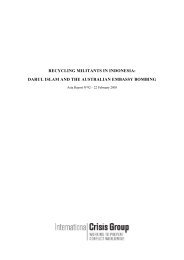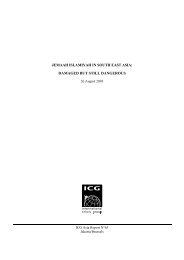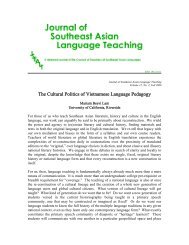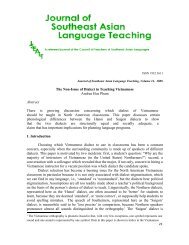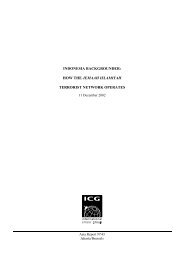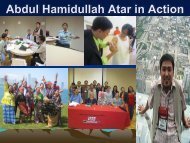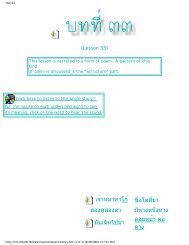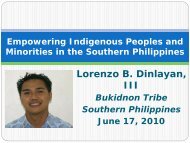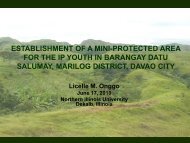Introduction - SEAsite - Northern Illinois University
Introduction - SEAsite - Northern Illinois University
Introduction - SEAsite - Northern Illinois University
Create successful ePaper yourself
Turn your PDF publications into a flip-book with our unique Google optimized e-Paper software.
Prentation Abstracts<br />
Group of the Southeast Asia Development Advisory Group (SEADAG). Following<br />
stints at UCLA, Brandeis <strong>University</strong>, and Harvard <strong>University</strong>, Prof. Emeritus<br />
Halpern retired in 1992 after teaching 25 years at the <strong>University</strong> of Massachusetts<br />
at Amherst. Digitalization of his extensive, nearly all, slide collection commenced<br />
at the <strong>University</strong> of Wisconsin-Madison in late 2003, with the metadata phase<br />
being completed in early 2005. As a part of SEAiT, the Halpern Collection very<br />
nicely constitutes the project’s initial component for Laos.<br />
The Halpern Collection provides a very interesting picture of activities<br />
and life in Laos, from royal ceremonies to rural scenes, from American aid to<br />
“hilltribe” communities. Its most distinctive feature is its extensive focus on Luang<br />
Prabang, the (then) royal capital, where Prof. Halpern and his wife, Barbara<br />
Kerewsky-Halpern, resided during their 1957 stay, as well as neighboring parts of<br />
northern Laos from that year and 1959, as well as Vientiane and vicinity. Among<br />
the Luang Prabang and northern Laos highlights are:<br />
(1) Coverage of several royal ceremonies, including the wedding of (then) King<br />
Sisavang Vong’s youngest son, Prince Manivong, in 1957;<br />
(2) A rural trip with Prince Phetsarath, the “Uparat”, or Viceroy, in 1957, shortly<br />
after he had returned from political exile; and<br />
(3) Numerous images of the region’s various ethnic minority “hilltribe” groups,<br />
in particular the Akha, Hmong, Khmu`, Lanten, Lu, Tai Dam, and Yao.<br />
Among the latter grouping, the Collection includes an especially rare set of<br />
images from the White Hmong village of Kiu Katiam in Luang Prabang province.<br />
The village, about 50 miles south of the city, was home to Father Yves Bertrais, a<br />
Frenchman of the Missionary Oblates of Mary Immaculate, from April 1950 until<br />
the end of 1959. In 1952, Father Bertrais was one of three missionary co-founders<br />
of the Hmong Romanized.<br />
Popular Alphabet (RPA), the script now most used by the Hmong around the<br />
world. Prof. Halpern’s Kiu Katiam images have been most significantly enhanced<br />
by the addition of personal information about individuals as well as the village<br />
through direct contact with Father Bertrais (working in Thailand at the time, December<br />
2004) and several White Hmong born in Laos who now live in the U.S. (at<br />
the same time).<br />
John Hartmann, Ph.D.<br />
Linguistic and Historical Continuities of the Tai Dam<br />
and Lao Phuan: Case Studies in Boundary Crossings<br />
<strong>Northern</strong> <strong>Illinois</strong> <strong>University</strong>, <strong>Illinois</strong><br />
One of the most salient and enduring features of ethno-cultural identity is<br />
language. The Tai Dam and Lao Phuan, just two examples of Tai ethnic minorities<br />
who migrated or were moved across the borders of Vietnam and Laos and resettled<br />
in Thailand as early as two centuries ago, are remarkable for having preserved<br />
their sense of ethnic uniqueness. Other Tai groups have similar histories and exhibit<br />
parallel cultural and linguistic continuities and processes of change: the Lue<br />
and Phu Tai, are two other examples that come readily to mind. Using the analytical<br />
tools of comparative-historical linguistics, we will examine one significant set<br />
of underlying language patterns that have persisted in the Tai Dam and Lao Phuan<br />
communities over time, namely tones. This paper presents a new description determined<br />
by Hartmann, Wayland, Thammavongsa in 2003 of the tonal array of Lao<br />
Phuan from Xiang Khuang, Laos to complement the analysis of Lao Lao Phuan<br />
tones recorded by Tanprasert (2003) in thirty-three villages of nineteen provinces<br />
in Thailand. The earlier work on Lao Phuan by Chamberlain (1971, 1975) is examined<br />
in light of these new findings. Tai Dam and Lao Song have identical tonal<br />
arrays that can be traced back to origins in northwestern Vietnam. Lao Phuan is,<br />
in terms of tonal patterns, a copy of Lao of Luang Prabang, except for its tell-tale<br />
split of the proto-Tai *B tone, which also provides the clearest marker of enduring<br />
continuity between Lao Phuan of Laos with all of the Lao Phuan dialects in Thailand.<br />
Prior classification of Lao speech domains by Hartmann (1980) into three<br />
regional dialects – <strong>Northern</strong> (Luang Prabang), Central (Vientiane), and Southern<br />
(Pakse) – is affirmed but refined by now calling them “Mekong Lao,” a notion<br />
borrowed from Crisfield (p.c.) as my means of drawing attention to the uniqueness<br />
of “non-Mekong” Lao Phuan. A cursory summary of some of the historical events<br />
and sociological factors that lend to the persistence of the language and culture of<br />
these two ethnic Tai groups will be presented. Their “tribal labels” are political<br />
constructs that refer back to historical states that no longer exist. Still, the preservation<br />
of underlying tonal patterns unique to both groups provides an interesting<br />
“linguistic DNA sample,” showing the continuity of language and culture across<br />
national boundaries and two centuries of Thai, Tai Dam, and Phuan history.<br />
Ellen A. Herda, Ph.D.<br />
The Place of Story, Silk and Song: Collaborative<br />
Development Practice in Lao<br />
<strong>University</strong> of San Francisco, California<br />
Drawing upon local story and talent, development practices have emerged in<br />
a variety of ways that bring people from the West who are not full-time professional<br />
developers to work with people in Lao on specific projects. Narrative analysis<br />
sets the foundation and direction for collaborative development practices carried<br />
out by Lao and American educators, musicians, social scientists and artisans. Establishing<br />
a relationship between an American school and a school in the remote<br />
province of Phongsali, hearing the stories of a small people group in Sayabury talk<br />
about the future, promoting the appreciation of Lao silk among urban and surburban<br />
Americans, and collaborating with a music demonstration theater in Vientiane<br />
are examples of development work that take on meaning through commitment<br />
and friendship. Assumptions about development are discussed and questions of<br />
sustainability and policy are considered from a critical hermeneutic orientation.<br />
Ellen A. Herda and Valerie Dzubur<br />
Interpreting Lao Development Through Story, Fabric,<br />
Education, and Music<br />
California, USA<br />
Based on travels and service work in Lao over the past four years, we have<br />
seen socioeconomic development take on various meanings and avenues. These<br />
two presentations provide insight into the changing nature of development from<br />
instrumental and technical service to a hands-on and collaborative mode. Examples<br />
are drawn from Luang Pra Bang, Sayabury, Vientiane, Phongsali. Implications<br />
for development policies are drawn from our work and are based in a critical<br />
hermeneutic orientation.<br />
Christy Hicks<br />
Lao Primary School Teachers’ Perceptions of the<br />
Developmental Stages of Youth in UXO-Impacted Communities<br />
Department of Family & Child Ecology, Youth Development Program, Michigan<br />
State <strong>University</strong>, Michigan<br />
Since 1999, volunteers from Thailand and the United States have worked in<br />
partnership with the Lao Ministry of Education and Consortium Lao to facilitate<br />
workshops in child-centered, multi-sensory learning. The volunteers believed that<br />
teachers attempt to meet the developmental needs of their students based upon<br />
their assumptions about youth development stages. These are the common physical,<br />
cognitive, social, and emotional characteristics of each age group with whom<br />
an educator works. The challenge for the facilitators was to determine whether perceptions<br />
about these developmental stages of youth are consistent across cultures<br />
(U.S., Thai and Lao), or influenced by environmental factors (i.e. the presence of<br />
unexploded ordinance in the community). This paper explores the similarities and<br />
differences in these perceptions, revealed through small-group discussions among<br />
Lao participants in the workshops.<br />
Shih-chung Hsieh, Ph.D.<br />
Constructing a Pan-Lue World—Community and Ethnicity<br />
among Lao Immigrants in Seattle<br />
Department of Anthropology, National Taiwan <strong>University</strong>, Taiwan<br />
The main Tai-speaking peoples distributed in Luang Namtha Province, Laos<br />
are Tai-Lue, Tai-Nuea, Tai-Dam, Tai-Daeng, Kalom and so on. Most of refugees<br />
escaped from northern Laos to Thailand, then moved to western countries such as<br />
US and France are members of those non-Lao Tai-speaking Laotians. At present<br />
there are around 100 Lue families in Seattle area of Washington State in US. They<br />
founded a Lao-Lue Association in 1979, four years after the first Lue had settled<br />
down there. In 1997, the Lue immigrants in Seattle bought a suburban land, and<br />
established a Buddhist temple named Wat Buddharam. They went to Lao temple<br />
usually before the Lue temple had been built up. The appearance of Lue temple<br />
symbolizes the success of practice of ethnicity. This particular group of people<br />
have re-planted “traditional” life out of homeland. One may feel a cultural atmo-






